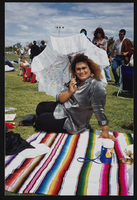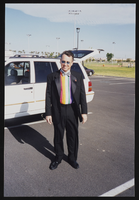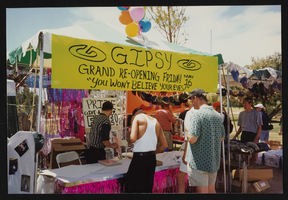Search the Special Collections and Archives Portal
Search Results
Guy Hamblin oral history interview
Identifier
Abstract
Oral history interview with Guy Hamblin conducted by Barry Merrell on February 22, 1975 for the Ralph Roske Oral History Project on Early Las Vegas. Hamblin discusses moving from different towns in Nevada before settling down in Southern Nevada, viewing the above-ground atomic bomb tests, early Fremont Street, and his work on the railroad. Hamblin also discusses the demographic and economic changes that he has seen in Las Vegas, Nevada.
Archival Collection
Barr Smith oral history interview
Identifier
Abstract
Oral history interview with Barr Smith conducted by Melvin Smail on February 22, 1980 for the Ralph Roske Oral History Project on Early Las Vegas. In this interview, Smith discusses his personal history and the history of Las Vegas, Nevada. Smith discusses working at the Basic Magnesium plant, playing high stakes poker games with prominent gamblers like "Nick the Greek," and the casinos built on the early Las Vegas Strip. Smith also describes how Las Vegas has changed, the different forms of gambling and gaming available in the city, and life in 1940s Las Vegas.
Archival Collection

Zina Tago at Gay Pride: photographic print
Date
Archival Collection
Description
Gay Pride at Sunset Park, 1998. Photographer: Dennis McBride. Zina Tago. At Sunset Park, 4-25-98.
Image

Rob Schlegel at Gay Pride: photographic print
Date
Archival Collection
Description
The third annual Gay Pride parade at Sunset Park, 1999. Photographer: Dennis McBride; Rob Schlegel. (5-8-99)
Image
Danel Boone oral history interview
Identifier
Abstract
Oral history interview with Danel Boone conducted by Daniel Pope on February 22, 1977 for the Ralph Roske Oral History Project on Early Las Vegas. During this interview Boone discusses why he came to Las Vegas, Nevada, the Helldorado parade, church activity, and the weather. Boone also discusses city parks, Boy Scouts, schools, above ground atomic tests, local history of Southern Nevada, and the ways in which Las Vegas has changed over the years.
Archival Collection
Notes and research on early Las Vegas history; The Oral History Project of the University of Nevada, Reno bibliography, 1971
Level of Description
Archival Collection
Pagination
- Previous page ‹‹
- Page 4
Archival Component
Nevada Test Site Oral History Project, Departments of History and Sociology Public History Program poster, 2008
Level of Description
Archival Collection
Pagination
- Previous page ‹‹
- Page 4
Archival Component
Equal Right to Marry Project event at the Gay and Lesbian Community Center of Southern Nevada: photographic prints, 1996 July 31
Level of Description
Archival Collection
Pagination
- Previous page ‹‹
- Page 4
Archival Component

Gipsy nightclub booth at Gay Pride: photographic print
Date
Archival Collection
Description
Image
Esther Langston oral history interview
Identifier
Abstract
Oral history interview with Esther Langston conducted by Claytee D. White on February 22, 2005 for the UNLV @ 50 Oral History Project. In this interview, Langston provides an overview of her early life and career in social work. She describes how the women in her family are positive and empowering role models. Langston moves on to explain how she become a social worker over a period of many years. She states that a job experience that helped her gain the qualifications of a social worker was working as an office manager at the Nevada Test Site. She also mentions how she has had to work with conflicts such as racial inequalities.
Archival Collection
